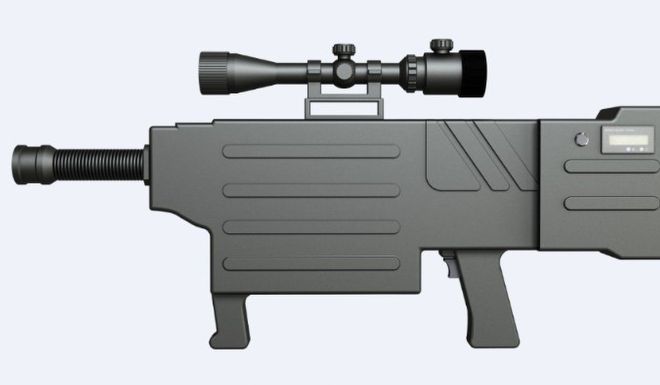According to an article by Stephen Chow of the South China Morning Post, China is making a “Laser AK47” that can set fire to targets one kilometer away. Ok, yes I know it is NOT an AK-47. I am quoting the source and the source clearly does not know what an AK-47 is. The laser assault rifle looks more like the Chinese QBZ bullpup rifles.
However, this rendering looks nothing like the top photo.

The ZKZM-500 laser assault rifle is classified as being “non-lethal” but produces an energy beam that cannot be seen by the naked eye but can pass through windows and cause the “instant carbonization” of human skin and tissues.
Ten years ago its capabilities would have been the preserve of sci-fi films, but one laser weapons scientist said the new device is able to “burn through clothes in a split second … If the fabric is flammable, the whole person will be set on fire”.
We have seen an article about China’s Military working on lasers to blind targets. But here is an actual laser that is man-portable and can set objects on fire. On YouTube, there is a young man who goes by StyroPyro and he builds lasers for fun. Here is a 200W Laser Bazooka that he built.
Now given that China seems to manufacture a lot of laser diodes, I could believe that they are taking advantage of that technology but to believe that they have a man-portable laser that can ignite clothing as far as a kilometer away is hard to believe.
“The pain will be beyond endurance,” according to the researcher who had took part in the development and field testing of a prototype at the Xian Institute of Optics and Precision Mechanics at the Chinese Academy of Sciences in Shaanxi province.
The 15mm calibre weapon weighs three kilos (6.6lb), about the same as an AK-47, and has a range of 800 metres, or half a mile, and could be mounted on cars, boats and planes.
It is now ready for mass production and the first units are likely to be given to anti-terrorism squads in the Chinese Armed Police.
In the event of a hostage situation it could be used to fire through windows at targets and temporarily disable the kidnappers while other units move in to rescue their captives.
It could also be used in covert military operations. The beam is powerful enough to burn through a gas tank and ignite the fuel storage facility in a military airport.
Because the laser has been tuned to an invisible frequency, and it produces absolutely no sound, “nobody will know where the attack came from. It will look like an accident,” another researcher said. The scientists requested not to be named due to the sensitivity of the project.
One aspect that makes this difficult to believe is atmosphere will be a hindrance to the laser. Moisture, smoke or any other particulates in the air will disperse the beam and decrease its effectiveness.
The other aspect is condensing and focusing a laser as far as one kilometer. Think of how kids use magnifying glasses to focus the sun and make a laser that burns leaves and other kids. I have serious doubts a series of lenses could focus a laser beam that far away to concentrate a laser to burn clothes 1km away. It might be powerful enough as a long distance laser hair removal device.
The rifles will be powered by a rechargeable lithium battery pack similar to those found in smartphones. It can fire more than 1,000 “shots”, each lasting no more than two seconds.
The prototype was built by ZKZM Laser, a technology company owned by the institute in Xian. A company representative confirmed that the firm is now seeking a partner that has a weapons production licence or a partner in the security or defence industry to start large-scale production at a cost of 100,000 yuan (US$15,000) a unit.
Given their potential for misuse, the design and production of the devices will be tightly monitored and the only customers will be China’s military and police.
I think this may be propaganda on China’s part? Until we see a video of this system actually working, I think it is safe to say it is the stuff of science fiction.
 Your Privacy Choices
Your Privacy Choices
